Bloodhound Diary: Talking big engines
- Published
A British team is developing a car that will be capable of reaching 1,000mph (1,610km/h). Powered by a rocket bolted to a Eurofighter-Typhoon jet engine, the vehicle will mount an assault on the land speed record. The vehicle will be run on Hakskeen Pan in Northern Cape, South Africa, in 2015 and 2016.
Wing Commander Andy Green, world land-speed record holder, is writing a diary for the BBC News website about his experiences working on the Bloodhound project and the team's efforts to inspire national interest in science and engineering.
I'm still smiling after the amazing weekend we had recently at the Goodwood Festival of Speed. Bloodhound's huge marquee was packed out with festival-goers talking to the team about the Bloodhound show car, its EJ200 jet engine, the massive aluminium diffuser floor (which had literally come straight from the factory), and the huge range of other bits we had on display.
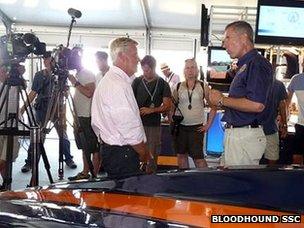
One at a time, please
Press interest was also intense, with two TV crews fighting each other for space at one stage. I dread to think what it's going to be like when we're running the car.
Outside, the kids were busy making and racing Bloodhound rocket cars (which is both difficult and impressive!), next to my personal favourite: the display of previous World Land Speed Record cars.
It was fascinating to compare some of the all-time greats side by side.
The oldest car was Malcolm Campbell's original Bluebird, the 350hp Sunbeam. This was the last track-racing car to hold the world record, as every record car after this one was purpose-built for the job.
The 1,000hp Sunbeam was there to remind us of the power of advertising. This car was powered by two Sunbeam Matabele engines, which dated back to the First World War. Each engine produced 435hp, so two of them produced... rather less than 1,000. However, if you write 1,000hp on the side of your car in large enough letters, you'd be amazed how many people will believe you.
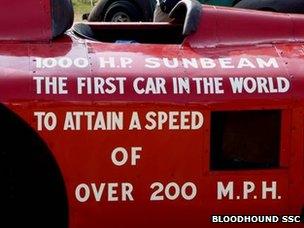
The power of advertising
They were telling the truth about the speed, though, as the Sunbeam was the first car to exceed 200mph. This may not sound very fast by today's standards, but in 1927 it was quite literally eye-watering for Henry Segrave, who raced this car down Florida's Daytona Beach in an open cockpit.
The 1,000hp Sunbeam didn't hold the record for long, as Campbell and American driver Ray Keech quickly set faster records.
Segrave responded with the beautiful Golden Arrow, which was perhaps the most efficient World Land Speed Record car in history. Two test runs in February of 1929, then two record runs in March, for a new world record of 231mph.
Campbell was devastated, as he'd just spent six months (and a lot of money) preparing a track in the Northern Cape of South Africa, and his car would only do about 215 mph. While Campbell missed his chance, I'm glad to say that the Northern Cape will finally get to host a World Land Speed Record when Bloodhound SSC starts running there in 2015.
Campbell finished his career in 1935, setting the first ever record over 300mph in the final version of Bluebird, which was also at Goodwood. Campbell had somehow managed to borrow a prototype engine (which was still classified) from the British government. The Rolls-Royce Type R engine, from the Schneider Trophy air race programme, gave him 2,300hp to play with.
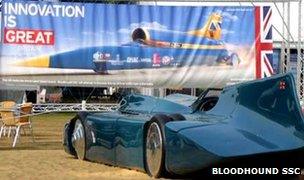
Bluebird and Bloodhound – world-beating engines
I supposed I shouldn't be surprised that Campbell managed to borrow such a special engine. Bloodhound SSC is also borrowing an ex-government prototype, in this case a development version of the Typhoon's EJ200 engine, external, one of the best engines in the world. Campbell would have approved.
Malcolm's son, Donald Campbell also set a World Land Speed Record in the extraordinary Bluebird CN7. This amazing design first appeared in public in 1960, running at the Goodwood race track (very slowly - it didn't do corners well) and this year it was back at Goodwood on public display once again.
This car had a composite bonded chassis, a head-up display, data logging and telemetry - it was decades ahead of its time. This was the last car to set a record by driving through the wheels. By the start of the 1960s, the jet age had arrived and Bluebird's 403mph record was very quickly eclipsed by the jet car speeds of over 600mph.
Since Bluebird, every land speed record has been set using jet power, with one exception.
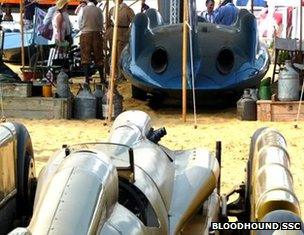
Golden Arrow (1929) watches Bluebird (1964)
The Blue Flame, the last of the record cars on display at Goodwood this year, used rocket power to set a World Land Speed Record in 1970 (622mph). That's about to change though - Bloodhound will be using a huge hybrid rocket, as well as the EJ200 jet engine, to power its way to 1,000 mph.
If you haven't seen the video of the Bloodhound rocket test last year, it's worth a look, external. Rocket power is delightfully simple, carrying both its fuel and oxidizer, and is generally smaller and lighter than a jet engine of similar power.
The Blue Flame used the same oxidizer that Bloodhound SSC will be using. Concentrated hydrogen peroxide is also known as "high test" peroxide, or HTP for short, and chemically it consists of H2O2 - a water molecule with an extra oxygen atom.
The HTP is forced through a catalyst pack with multiple layers of silver-plated mesh, which breaks the H2O2 down into water (H2O) and oxygen, and releases lots of heat. The big difference between the two cars is the the fuel. Blue Flame used liquid natural gas (which is where the name "Blue Flame" came from), while Bloodhound is using solid rubber (specifically, hydroxyl-terminated polybutadiene, if you really want to know).
The big problem with rockets is the huge amount of fuel (and oxidizer) that they consume. The Blue Flame was so heavy when it set off that it used to run out of fuel well before the end of the measured mile. The team eventually used a rolling start, pushing the Blue Flame with a Ford V8 to get it moving, which saved just enough fuel to set the record.
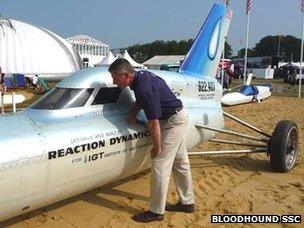
Push-start? Really?
I'm not sure if this solution would be legal under the current FIA rules, which require a land vehicle to be propelled "by its own means", but in any case Bloodhound has found a better solution. We've got the EJ200 jet engine to get us up to over 300mph (which qualifies as a pretty good push start!). At this point, the rocket joins in to give Bloodhound around 2g of acceleration (that's the equivalent of zero to 60mph in one-point-five seconds - in other words, a lot). By using a jet and a rocket, we've got the best of both worlds.
This month, we've been discussing Bloodhound engine performance with Rolls-Royce.
The great news is that we will be able to use full power immediately, from stationary. This might sound obvious, but for jet engines it's not a given.
For aircraft, which need a lot of power at low speed for takeoff, the size of the intake is a compromise to provide reasonable performance at all speeds. For Bloodhound, the intake is optimised for high speed (around Mach 1.2, or 900+ mph) to give minimum drag and maximum power as we approach 1,000mph. However, nothing comes for free. The 900mph intake is too small to allow the jet to suck in the air it needs for full power when the car is moving slowly.
The clever solution to this (which has taken a lot of help from Rolls-Royce) is to fit extra intakes on the sides of Bloodhound's body, known as "auxiliary" intakes, to provide extra air for full power at low speed. This solution (which is also used by a lot of military aircraft) means that we don't waste any time (or distance) in getting the engine up to full power and accelerating the car.
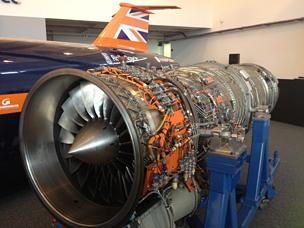
The power-dense EJ200 was designed for the Eurofighter-Typhoon
It will allow us to do full-power static tests, external of the engine, once it's installed in the car. It will also let me select full power for the runway tests in the UK, which should be quite a sight. I won't get to see it, of course, (I'll be inside the car) but you can come and watch. We'll have a UK test day for our 1K Supporters Club members, external.
Before we install the engine, each separate piece of the system will be tested. This has already started, with the EJ200's "AMAD gearbox already mounted on a test rig.
The gearbox is being spun up to 10,500RPM, the speed at which the generator kicks in, so that we can test the generator control circuits as well.
The generator's job is to produce the alternating current (AC) electricity for the fuel pumps. The pumps will in turn feed high pressure Jet-A fuel to the EJ200 at maximum power (which you can come and watch, if you've just used the link above to join the Supporters' Club). If you want to build a 1,000mph car and run it safely, which we do, then there's a lot to testing to be done first.
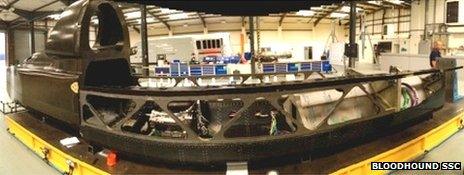
Waiting for a jet engine
Our supply chain manager, Conor La Grue, has just produced a summary of the build activity, external, and there's a lot going on. The chassis side rails are now in position, so the team is starting to work on the upper-chassis, where the EJ200 will hang. In about 10,000 rivets' time, they will complete the structure to mount the jet engine in the car. Can't wait to see the engine installed: it's going to look amazing.
The chassis was joined for the first time last month, with government assistance. The Rt Hon David Willetts MP, Minister for Science, did up the first nut to join the carbon fibre monocoque (my "1000 mph office") to the rear lower-chassis.
His support for the Bloodhound Education Programme was even more welcome, as he announced a £1m government grant to support Bloodhound's research and education efforts.
There's a national shortage of scientists and engineers, and Bloodhound's "Engineering Adventure, external" is already making a difference, so this grant is a big vote of confidence for our education team. We've got around 5,500 schools signed up in the UK. If your local school isn't already taking part, get them to sign up here, external. It's time for an adventure...
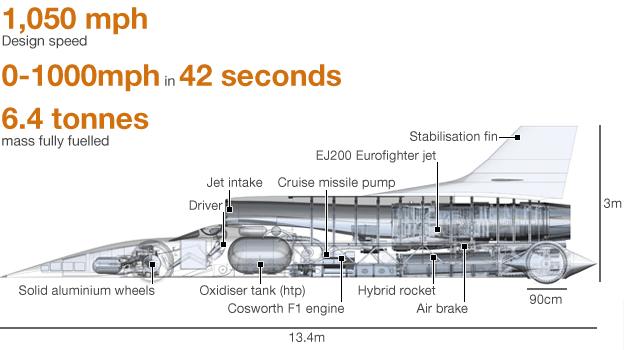
Image: Bloodhound SSC
- Published8 August 2013
- Published4 July 2013
- Published13 May 2013
- Published3 October 2012
- Published7 February 2011
- Published5 March 2011
- Published13 November 2010